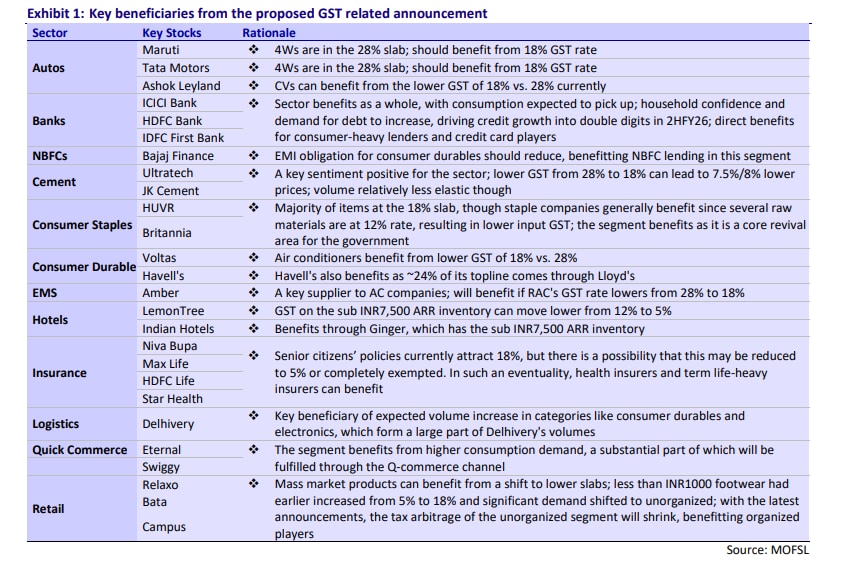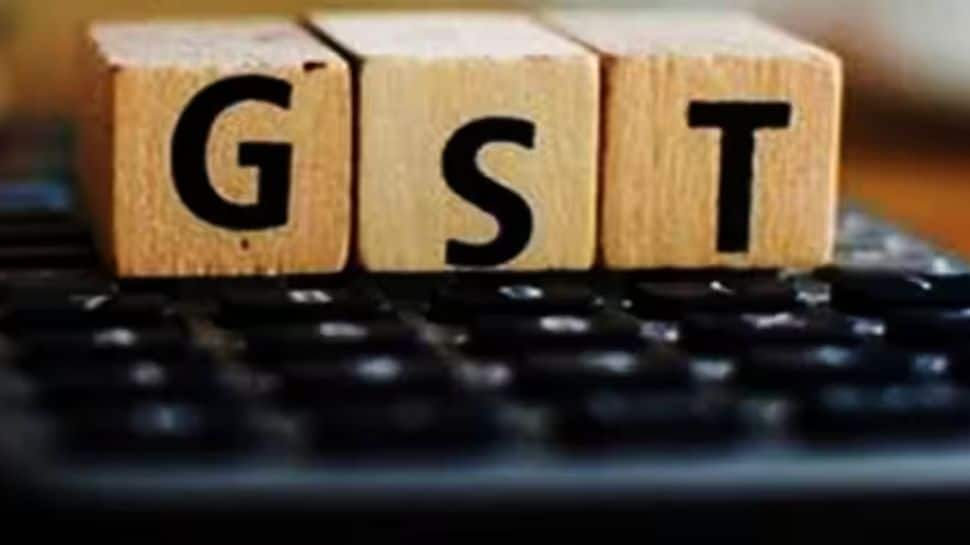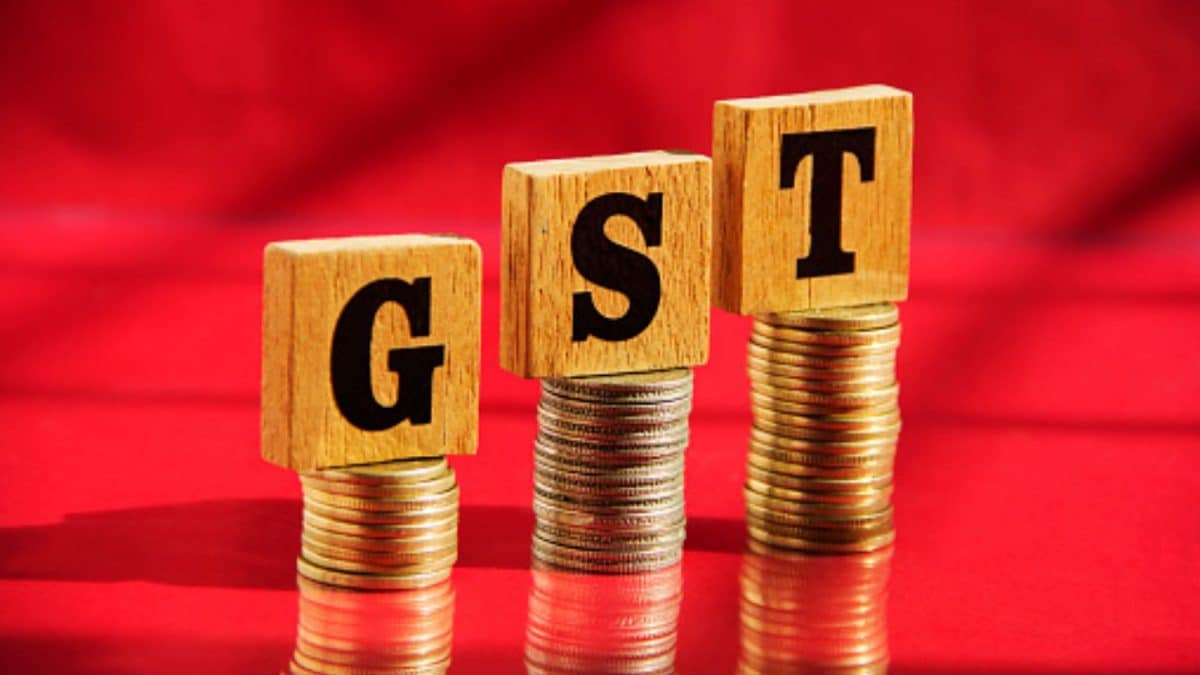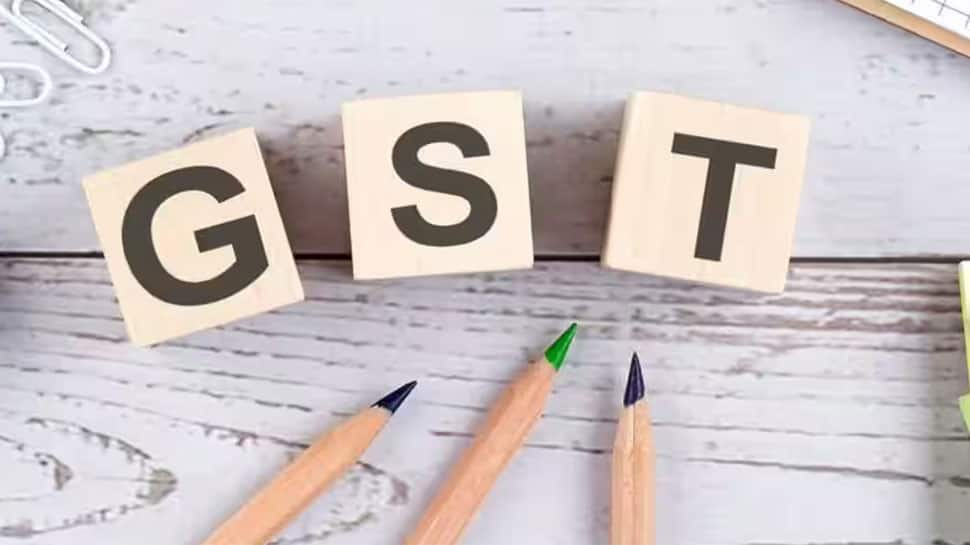Business
These 26 Stocks Are Expected To Benefit From Upcoming GST Reforms; Details Here
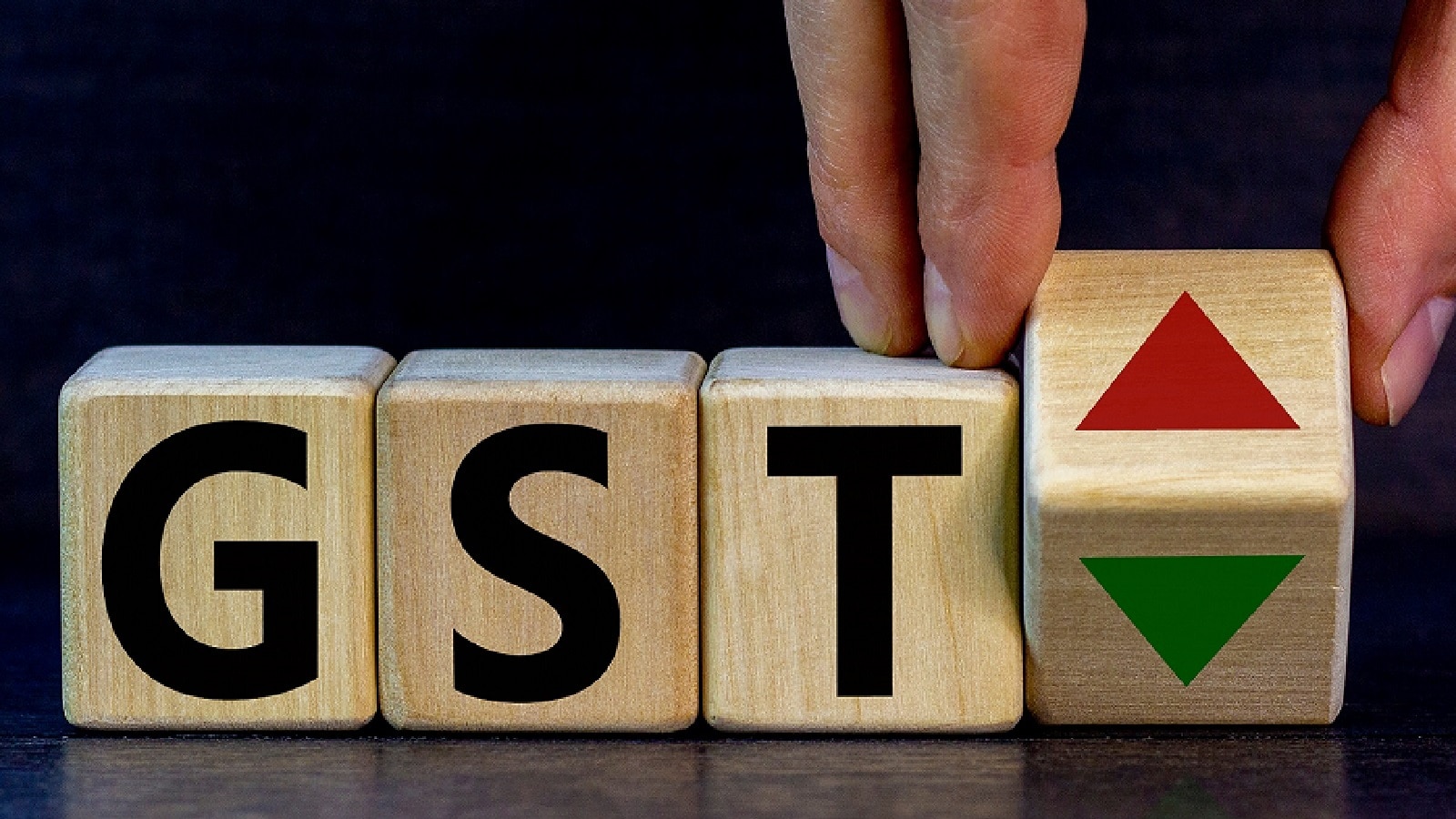
Last Updated:
Brokerage firm Motilal Oswal Financial Services (MOFSL) in its latest report gives a list of 26 stocks that are likely to benefit from the proposed GST ‘big bang’ reforms.

With consumption expected to pick up, banks such as ICICI Bank, HDFC Bank and IDFC First Bank are set to benefit from stronger credit demand, particularly in consumer loans and credit cards, says MOFSL.
Indian equity markets are set for a strong start to the week as sentiment turns upbeat following Prime Minister Narendra Modi’s Independence Day announcement of a major overhaul in the Goods and Services Tax (GST) structure. The proposed changes, widely referred to as GST 2.0, aim to simplify the tax regime and boost consumption, with analysts flagging multiple sectors that stand to gain.
According to reports, the Centre is considering scrapping the current 12% and 28% GST slabs, realigning most items into the 5% and 18% categories. Certain sin or luxury goods may be placed in a new 40% bracket. The rejig is expected to help stimulate demand and support India’s growth momentum.
Brokerage firm Motilal Oswal Financial Services (MOFSL) in its latest report on August 18 gives a list of 26 stocks that are likely to benefit from the proposed GST ‘big bang’ reforms. It said the move could unlock opportunities across autos, cement, consumer staples, durables, retail, and financials, while also easing compliance for businesses.
Autos to Drive Ahead
Motilal Oswal said passenger vehicle makers Maruti Suzuki and Tata Motors, currently paying 28% GST, are expected to benefit significantly if rates are lowered to 18%. Commercial vehicle maker Ashok Leyland may also see demand tailwinds as GST on trucks and buses comes down to 18% from the current 28%.
Banks and NBFCs in Focus
With consumption expected to pick up, banks such as ICICI Bank, HDFC Bank and IDFC First Bank are set to benefit from stronger credit demand, particularly in consumer loans and credit cards. Among NBFCs, Bajaj Finance could see reduced EMI obligations on consumer durables, improving affordability and driving loan growth, according to MOFSL.
Cement and Building Materials to Gain
Lowering GST on cement from 28% to 18% could cut prices by up to 7.5-8%, Motilal Oswal estimates. This would be a key sentiment booster for the sector, especially for majors like UltraTech Cement, JK Cement, and HeidelbergCement (HUWR), given cement’s relatively inelastic demand profile, MOFSL said.
Consumer Staples and Durables
In FMCG, most products currently taxed at 18% may remain unchanged, but companies such as Britannia could benefit as input costs reduce — since many raw materials attract 12% GST today.
Consumer durable companies stand to gain more directly. Voltas could benefit from a lower GST on air-conditioners, while Havells would gain as about 24% of its sales come from Lloyd ACs, which may see a cut from 28% to 18%, according to MOFSL.
Electronics Manufacturing & Hotels
Electronics maker Amber Enterprises, a key supplier to AC brands, is expected to benefit from lower GST on RACs. In hospitality, Lemon Tree Hotels and Indian Hotels may see improved profitability as GST on sub-Rs 7,500 room tariffs is proposed to be cut from 12% to 5%, the brokerage firm said.
Insurance and Financial Services
The GST rejig could also support insurers. Currently, premiums on life and health policies attract 18% GST. Analysts believe this may be reduced to 5% or exempted altogether, boosting affordability and demand. Niva Bupa, Max Life, HDFC Life and Star Health could be key beneficiaries, it added.
Logistics, Retail and Quick Commerce
Delhivery may gain from higher volumes of consumer durables and electronics if demand revives. In quick commerce, Eternal and Swiggy stand to benefit from increased discretionary spending, MOFSL said.
Retailers like Relaxo, Bata and Campus may also be winners as mass footwear (below Rs 1,000) — earlier taxed at 18% from 5% — could shift back into a lower bracket, narrowing the tax arbitrage between organised and unorganised players.
Market Outlook Today
The GST overhaul has been welcomed by markets, with analysts expecting a consumption-driven rally across auto, cement, FMCG, and financial names. Early trends in GIFT Nifty suggest a gap-up opening, with the index trading 266 points or 1.07% higher at 24,921 in pre-market hours.

Haris is Deputy News Editor (Business) at news18.com. He writes on various issues related to personal finance, markets, economy and companies. Having over a decade of experience in financial journalism, Haris h…Read More
Haris is Deputy News Editor (Business) at news18.com. He writes on various issues related to personal finance, markets, economy and companies. Having over a decade of experience in financial journalism, Haris h… Read More
view comments
Read More
Business
Stock Market Live Updates: Sensex, Nifty Hit Record Highs; Bank Nifty Climbs 60,000 For The First Time

Stock Market News Live Updates: Indian equity benchmarks opened with a strong gap-up on Monday, December 1, touching fresh record highs, buoyed by a sharp acceleration in Q2FY26 GDP growth to a six-quarter peak of 8.2%. Positive cues from Asian markets further lifted investor sentiment.
The BSE Sensex was trading at 85,994, up 288 points or 0.34%, after touching an all-time high of 86,159 in early deals. The Nifty 50 stood at 26,290, higher by 87 points or 0.33%, after scaling a record intraday high of 26,325.8.
Broader markets also saw gains, with the Midcap index rising 0.27% and the Smallcap index advancing 0.52%.
On the sectoral front, the Nifty Bank hit a historic milestone by crossing the 60,000 mark for the first time, gaining 0.4% to touch a fresh peak of 60,114.05.
Meanwhile, the Metal and PSU Bank indices climbed 0.8% each in early trade.
Global cues
Asia-Pacific markets were mostly lower on Monday as traders assessed fresh Chinese manufacturing data and increasingly priced in the likelihood of a US Federal Reserve rate cut later this month.
According to the CME FedWatch Tool, markets are now assigning an 87.4 per cent probability to a rate cut at the Fed’s December 10 meeting.
China’s factory activity unexpectedly slipped back into contraction in November, with the RatingDog China General Manufacturing PMI by S&P Global easing to 49.9, below expectations of 50.5, as weak domestic demand persisted.
Japan’s Nikkei 225 slipped 1.6 per cent, while the broader Topix declined 0.86 per cent. In South Korea, the Kospi dropped 0.30 per cent and Australia’s S&P/ASX 200 was down 0.31 per cent.
US stock futures were steady in early Asian trade after a positive week on Wall Street. On Friday, in a shortened post-Thanksgiving session, the Nasdaq Composite climbed 0.65 per cent to 23,365.69, its fifth consecutive day of gains.
The S&P 500 rose 0.54 per cent to 6,849.09, while the Dow Jones Industrial Average added 289.30 points, or 0.61 per cent, to close at 47,716.42.
Business
South Korea: Online retail giant Coupang hit by massive data leak

Osmond ChiaBusiness reporter
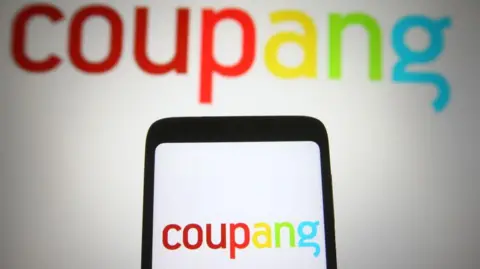 Getty Images
Getty ImagesSouth Korea’s largest online retailer, Coupang, has apologised for a massive data breach potentially involving nearly 34 million local customer accounts.
The country’s internet authority said that it is investigating the breach and that details from the millions of accounts have likely been exposed.
Coupang is often described as South Korea’s equivalent of Amazon.com. The breach marks the latest in a series of data leaks at major firms in the country, including its telecommunications giant, SK Telecom.
Coupang told the BBC it became aware of the unauthorised access of personal data of about 4,500 customer accounts on 18 November and immediately reported it to the authorities.
But later checks found that some 33.7 million customer accounts – all in South Korea – were likely exposed, said Coupang, adding that the breach is believed to have begun as early as June through a server based overseas.
The exposed data is limited to name, email address, phone number, shipping address and some order histories, Coupang said.
No credit card information or login credentials were leaked. Those details remain securely protected and no action is required from Coupang users at this point, the firm added.
The number of accounts affected by the incident represents more than half of South Korea’s roughly-52 million population.
Coupang, which is founded in South Korea and headquartered in the US, said recently that it had nearly 25 million active users.
Coupang apologised to its customers and warned them to stay alert to scams impersonating the company.
The firm did not give details on who is behind the breach.
South Korean media outlets reported on Sunday that a former Coupang employee from China was suspected of being behind the breach.
The authorities are assessing the scale of the breach as well as whether Coupang had broken any data protection safety rules, South Korea’s Ministry of Science and ICT said in a statement.
“As the breach involves the contact details and addresses of a large number of citizens, the Commission plans to conduct a swift investigation and impose strict sanctions if it finds a violation of the duty to implement safety measures under the Protection Act.”
The incident marks the latest in a series of breaches affecting major South Korean companies this year, despite the country’s reputation for stringent data privacy rules.
SK Telecom, South Korea’s largest mobile operator, was fined nearly $100m (£76m) over a data breach involving more than 20 million subscribers.
In September, Lotte Cards also said the data of nearly three million customers was leaked after a cyber-attack on the credit card firm.
Business
Agency workers covering for Birmingham bin strikers to join picket lines

Agency workers hired to cover Birmingham bin strikers will join them on picket lines on Monday, a union has said.
A rally will be held by Unite The Union at Smithfield Depot on Pershore Street, Birmingham, on Monday morning to mark the first day of strike action by agency refuse workers.
Unite said the Job & Talent agency workers had voted in favour of strike action “over bullying, harassment and the threat of blacklisting at the council’s refuse department two weeks ago”.
The union said the number of agency workers who will join the strike action is “growing daily”.
Strikes by directly-employed bin workers, which have been running since January, could continue beyond May’s local elections.
The directly-employed bin workers voted in favour of extending their industrial action mandate earlier this month.
Unite general secretary Sharon Graham said: “Birmingham council will only resolve this dispute when it stops the appalling treatment of its workforce.
“Agency workers have now joined with directly-employed staff to stand up against the massive injustices done to them.
“Instead of wasting millions more of council taxpayers’ money fighting a dispute it could settle justly for a fraction of the cost, the council needs to return to talks with Unite and put forward a fair deal for all bin workers.
“Strikes will not end until it does.”
-

 Sports1 week ago
Sports1 week agoWATCH: Ronaldo scores spectacular bicycle kick
-

 Entertainment1 week ago
Entertainment1 week agoWelcome to Derry’ episode 5 delivers shocking twist
-

 Politics1 week ago
Politics1 week agoWashington and Kyiv Stress Any Peace Deal Must Fully Respect Ukraine’s Sovereignty
-

 Business1 week ago
Business1 week agoKey economic data and trends that will shape Rachel Reeves’ Budget
-

 Tech6 days ago
Tech6 days agoWake Up—the Best Black Friday Mattress Sales Are Here
-

 Fashion7 days ago
Fashion7 days agoCanada’s Lululemon unveils team Canada kit for Milano Cortina 2026
-

 Politics1 week ago
Politics1 week ago53,000 Sikhs vote in Ottawa Khalistan Referendum amid Carney-Modi trade talks scrutiny
-

 Tech6 days ago
Tech6 days agoThe Alienware Aurora Gaming Desktop Punches Above Its Weight


